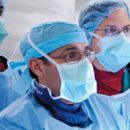To date, not one medical information system has been created. But whether these software products fully meet the needs of health care? Whose software should be focused on medicine? The author of the article outlines its opinion on this issue.
Content
So, for whom medical information systems are being developed?
 «What a question? - The reader is surprised. - At a minimum, for a doctor. And also for the head of the department, for the chief physician, for medical statistics. And a lot for someone else». Everything is so but for what doctor? For which head, chief physician, statistics? How represents their developer? How does he try to assist them with his means? Is it true and are true of its ideas about the users of the automated system? Varnishes in it more closely.
«What a question? - The reader is surprised. - At a minimum, for a doctor. And also for the head of the department, for the chief physician, for medical statistics. And a lot for someone else». Everything is so but for what doctor? For which head, chief physician, statistics? How represents their developer? How does he try to assist them with his means? Is it true and are true of its ideas about the users of the automated system? Varnishes in it more closely.
When it comes to automation, the doctor appears in the image of a person overloaded with routine paper work distracting from the present case. He is poorly informed due to the imperfection of manuscript documentation, due to the archaic of the system of document management and for a number of other reasons. He is unheated - it can easily distract from working with patients as its leaders and different controllers. Poor and suburban, he in trouble with the patient - also extreme. It is clear that all this affects the results of its activities. And what is the demand from him?
This image of the doctor - really, and not the whole truth, and something over the truth. But, be that as it may, the general conclusion will not challenge: the doctor should be helped. That's just a specific assistance in general performances are not built - the details are needed. And if there are unaccounted essential details, and even invented non-existent, then with all the desire to do «How best» will surely succeed «as always».
What needs to be done if we proceed from the mentioned (common and very simplified) ideas about the doctor? To give it modern ways to enter information into the history of the disease, to implement the principle of one-time entry of information and its repeated use. Make the disease history themselves readable and affordable for all interested parties (so that the doctor does not fuck). Print the history of the disease for everyone who needs it and who has it right. Automate the generalization, sorting and grouping statistics, including reporting and lists. Finally, it is necessary to automate document flow - the transfer of data on patients from some participants of the medical diagnostic process to others. And then see how good.
Figure head of the department The developers almost do not pay attention. What for? What is special here? Head - the same attending physician, only the best or one of the best in the team, and therefore it is responsible for the rest, as well as administrative duties. Administration will be left aside, and medical concerns are that he, in addition, he also diagnoses and treats, also controls his subordinates, advises them and even a lot of money for them. He takes over the most difficult and responsible, in the rest of his position does not differ from the position of the attending physician. So, with changes in the attending doctors will change for the better and will simplify the work of the head. How don't it be easier for her if information about the work of the orders becomes truly affordable, and the doctors themselves, liberated by automation, will work better and worry about them less?
With medical statistics and it is simply simple: it will no longer count, it will stop making tables, it will only check the correctness of the most important information entered by doctors, to print all necessary documents from the database and monitor only in order to send them on time.
That to the chief physician, then there are no difficulties. This is an administrator, a businessman, from clinical work who has been departed, and to work with non-medical information (finance, personnel and so.) he has experts. He himself does not need anything from automation, and the work of assistants - an accountant, economist, personnel - must automate. True, deputies for medical sections of work, but they perform mainly control functions, and the conditions for this have already been radically improved, since the history of the disease has become informative, readable and easily accessible. Note, dear reader, I'm not talking about the doctor and the main doctor, but how many developers of medical information systems are painted. Portraits this or cartoons - they recognizable. The overall picture is not deprived of the truth, and most importantly - it is simple in such a specific area as medical practice, suggests simple solutions. Parcels in front of the conclusions of them are unambiguous.
On Health Automation: Reflections on the topic
But what if the parcels are not quite correct or suffer from significant omissions? What then are the hopes based on them to improve medical care? But the incompleteness (and in places - the wrong) of the described starting positions is not so difficult to detect. The most important omission is that the participants of a single medical and diagnostic process are considered isolated from each other. Meanwhile, they are in constant interaction, which is not at all coming down to routine document flow. Here, for example, one of the almost not mentioned problems of the doctor: it may not be provided by the fact that it prescribes the patient, or ensure with the delay. The problem of continuity in the transition of a patient from one doctor to another remains outside: in the same conditions, they can examine and treat in different ways.
Such specific functions of the department of the department, as concern for continuity, on compliance with all doctors of some standards and regulations of patients, on comparative evaluation of doctors. This practice does not occupy such a practice when in the history of the disease already dropped out of the patient's hospital medical statistics is necessary, without the knowledge of the doctor, correct the diagnosis code and the type of operation as it seems to him more correct (beneficial for the report). Do not do it - in statistics and really fall inaccuracies and mistakes. What will happen to this problem when automation?
Finally, why should I agree that the chief physician stopped being a physician? It would be nice to understand that only by the administrator and a businessman he becomes unavailable, due to the lack of relevant information support, and not at all because the position does not require any medical knowledge, nor independent medical decisions. As required! And it is the automation that should be restored, and satisfy, not to mention the fact that deputies of the chief physician for medical sections never left such solutions.
Now take a look at the situation on the other side. We unloaded doctors - how they use it? Total answer - «will give more time to patients» - Does not encourage. Patients need a healing force of accurate medical knowledge, and not just a doctor's time. But the carriers of this knowledge will remain the same. It is unlikely that the sloppy will become neat, forgetful - a memorial, who knows little - more knowledgeable, Haltruchik - conscientious. I agree, no one will not be worse, but will anyone become better? How? And what we do with the statistics, for which everyone will consider and consider? Reduce? Maybe, but the fate of patients is not related. And the leaders of the middle and upper levels - what is the hope that they will be better to manage, on which mechanisms? By themselves, the advantages of the electronic history of the disease and the notorious unloading of doctors do not respond to these questions. To improve medical care, something else is required of automation. If, of course, tie with her this main goal. Otherwise, why was a garden to ride?
There is an important circumstance in the light of which a simplified picture drawn by superficial imagination changes, becomes a volume, acquires perspective. It comes down to the fact that automation based on the electronic history of the disease does not make it easier, but radically changes the implementation of informational functions of the attending physician - the central figure of the medical diagnostic process around which the medical world is spinning from which it feeds on information. This radical change of activity changes both the person himself, and its environment. Now everyone gets what they did not receive earlier - timely, full and reliable information. From here Other opportunities, other responsibility, other ideas about their responsibility for the use of opportunities, other self-education.
But how to use new opportunities? Create accessible databases - the same thing to build well organized warehouses. Participants in the medical and diagnostic process, these data should not be necessary to extract - they must be compared with different purposes, to conjugate, recycle into a product - in a variety of solutions. It was either not done at all, or was made partially, sporadically and on the eyes, because otherwise it was impossible. The deficit of accurate information was complemented by a subjective attitude to the problem: personal interest, intuition, sympathies and antipathies, pressure from the outside. Now, when there is exact information, you need adequate tools for everyday work with information, you need another decision-making style. Medical information systems should be created in settlement by this perspective, focusing not at today's participants in the medical diagnostic process, but on such what they will become, should be in automation conditions.
For the development of medical information systems, there are not enough ideas about today's doctors; there are insufficient. They tell the developer from what to repel. This, however, is not the same thing to know what to strive for. Yes, to get rid of deficiencies, it is enough to see these shortcomings. Suppose they can be visible. But how to use the new condition after the deliverance? How wisely dispose of new freedom? And if you remember that freedom obliges responsibility, then how to work at the level of new responsibility? Obviously, it is necessary to imagine a certain ideal and a new system in advance to move towards it. This last today is not enough.
Employees freed from what can take on technology, and provided timely, full and reliable information - these are other people. They have other starting positions for mental activities, for decision-making. They can take on new tasks, and many of them will want. The novelty of tasks at the same time, of course, is relative. It always boils down to the hippocratic oath, to the best use of available means for helping the patient. Only today information technologies are in the number of these funds. They allow you to best use everything else, accumulating, processing and feeding information to doctors. Let's see how automation changes the position of participants in the medical and diagnostic process and their themselves and what should be provided to developers.
Let's start with the attending physician. It became the history of the disease electronic - readable and affordable. Therefore, it will be read. And unencrypted by medical handwriting the text will find all its wealth, and the whole beauty. Spaces in important information will be visible, and inconsistencies of cases of plans, and missed deadlines, and spelling pearls. The responsibility of the doctor for information is significantly increased. Whether did a programmer, whether all his means used their doctors to work at the level of this new responsibility? As far as they insured against mistakes, also omissions in the description of the patient, in diagnostic and therapeutic purposes? Provided whether directories and templates of ready-made texts, pre-subjected to a medical and literary editorial office, or provided doctors to fill out reference books themselves and compose templates with the risk of replication of inaccuracies and illiteracy?
Whether the entry is insured by entering the information that is key to search and processing data? Error in the date in the century in the usual history of the disease will cause a smile of the reader, and in electronic - colossal changes in the calculations. Latin and Russian letters, similar to the draw, do not differ an eye, and the computer will look for not that surname or not that diagnosis. If there is no insurance, it's bad. Insurance should be.
But there are things and more cooking. Fundamentally the possibility of a doctor has grown. From some routine procedures, he is completely relieved, from other partially. The information you need for a case is not destroyed in papers. He can always see his work, plans, all that has not yet been done. His problems, if he reflects them, are available to see the head. But it is - in principle. And whether a programmer provided a doctor to the effective use of these opportunities: reminders of the not yet made, about the coming or missed deadlines, the transfer of its requests for the appointment, the notice of managers about the problems that the doctor himself cannot solve?
Considerable new opportunities mean responsibility for their use, increasing responsibility for the result. But if there are no special tools to implement such capabilities, then the result will not be. The doctor will not work at the level of his new responsibility. His flaws will be visible much better. They will be visible to all who are not too lazy, but whether they will be much less if the developer did not take care of the appropriate ways of automatic and automated tracking for the full, and timely data in the history of the disease? The doctor must be able to quickly look around the entire field of activity and see patients who require special attention, their unfulfilled plans, delays with the actions of consultants and laboratory technicians, to see those who have to come to the reception, and those who are thoroughly late Other. There will be no funds for such a review, for rational sorting of everyday worries - the work of the doctor will not be more effective.
Let us now turn to the position of the head of the department in automation. Now any disease story is available to him, any readable. You can, not touching doctors, check how they perform the installation of the head, timely detect their omissions, detect complex patients, where it is necessary to help your experience as your experience and knowledge. Once you can, then you need. But you can not only. The structure of the electronic history of the disease makes it possible to make a variety of calculations and compare doctors for a variety of quantitative (but reflective and quality!) Characteristics: by the number of patients, the number and types of established diagnoses, according to favorite means of diagnosis and treatment, according to expenses and outcomes. Now you can penetrate each doctor's kitchen, understand it, to understand what it is stronger, and in what weaker colleagues, to strengthen its weaknesses. And then according to the same indicators to follow how he under the influence of the analysis of his work is improving.
All this necessarily appears in principle and means simultaneous significant increase in the responsibility of the department. But there is special tools to work at the level of such responsibility? There must be a sample of sampling stories for a number of specific signs. In the history of the disease, it is necessary to be able to make a note of defects, give recommendations. It is necessary to have automatic input mechanisms in the history of destination diseases, which should be made to install the headset for certain categories of patients. Finally, it is necessary to have the function of accounting for the work of each doctor and the comparative analysis of the work of doctors for periods and quarterly segments of time. If this is done, opportunities will be used. If there is no such tool, they will disappear.
The possibilities (and responsibility) of the chief physician and his deputies increase even more. Their review is now available actions of all doctors and their ratio with resource spending. Do not be a specialist in a particular clinical area to understand: the work of the doctor who, with other things being equal, systematically spends more, and recognizes and cures less, needs correction. You do not need to be a clinician to figure out that the head of which the scatter in the performance of doctors is especially great, should especially work with its own qualities. It is necessary to be simply an organizer to compare the use of new means of diagnosis and treatment with the structure of the outcomes, the movement of the dispensary contingents, the use of a kainy fund. And T.D., and T.NS.
But in order for such opportunities to really use, a solid analytical apparatus should be in the medical information system. The chief doctor should be issued regular analysis on a specific program and, moreover, additional analytical materials on its special, conjunctural request. The list of these requests is quite limited, they are all about costs and results, but is the most important thing - with the possibility of differentiation of doctors and branches, that is, with identifying personal responsibility for success and failures. Tools for such an analysis can and need to prepare in advance. And using them, the chief physician will add here his medical knowledge, his personal clinical experience. If there is no such toolkit, it will remain with today's reputations «Businessman» but only.
Finally, about medical statistics. What to do it, if everything thinks, forms and prints a computer? And now they need to represent all the possibilities of operational and retrospective analysis of the work of the institution, divisions and individual doctors. The Cabinet of Medical Statistics Gets the opportunity to become a real analytical block of the management system, which performs the installation of the main doctor for tracking the state of affairs, in a timely manner informs it and the heads of the departments about weak places, evaluates the effectiveness of the control influences. For this, of course, a complex of analytical programs is needed. Made their programmer? If not done, medical statistics will remain at the current level of its value.
So, the medical information system must be developed not for today, but for tomorrow's figures, for physicians in the conditions of using electronic history. To do this, you need to imagine these conditions that do not exist today, compare them with the internal needs of the medical and diagnostic process and with its endful goals. It is necessary to evaluate the difference in personal responsibility for the final results in the face of bad awareness and at full awareness, and submitting and appreciating all this, to provide a doctor, its leaders and medical statistics tools to be implemented by a well-known thesis: «Who owns information, owns the situation». Very right: little to have information, it is necessary to own it.
The conviction of the situation today is that all the developers have not been said to all the developers, and the attending doctors and the main doctors do not formulate the task. Moreover, even having received such funds to their disposal, they use them for a very long time to an insignificant degree: no skills in most of today's doctors, nor a systemic look at their activities, no external incentives. They are today. Those who consciously seek to make automation by their main tool in working with information, very little. But they are, they are tomorrow. And after all will come new, with new skills, new aspirations, with the desire to seek with the help of information technologies of good end results, and not the notorious «relief». Automation should provide them with high efficiency.









